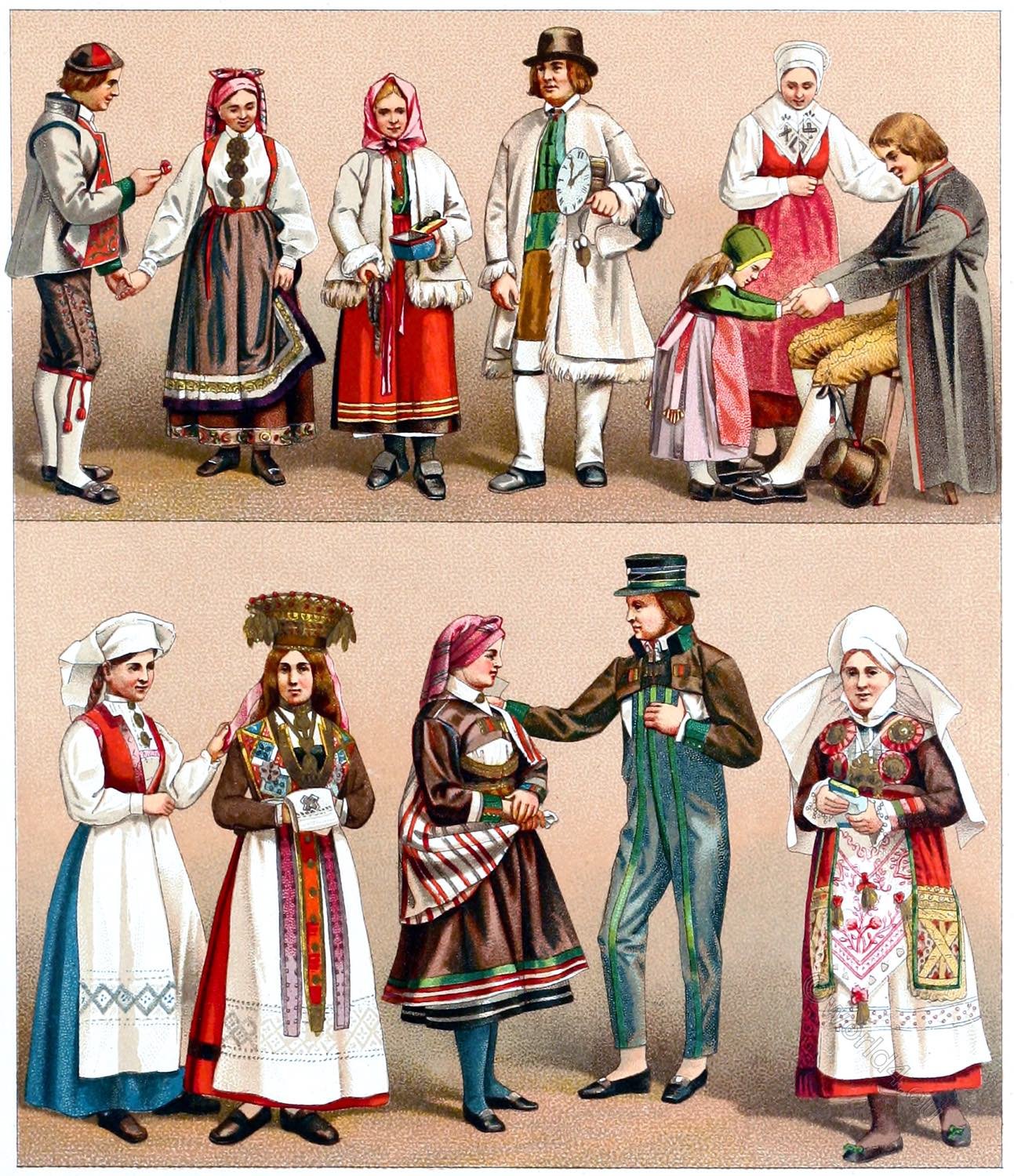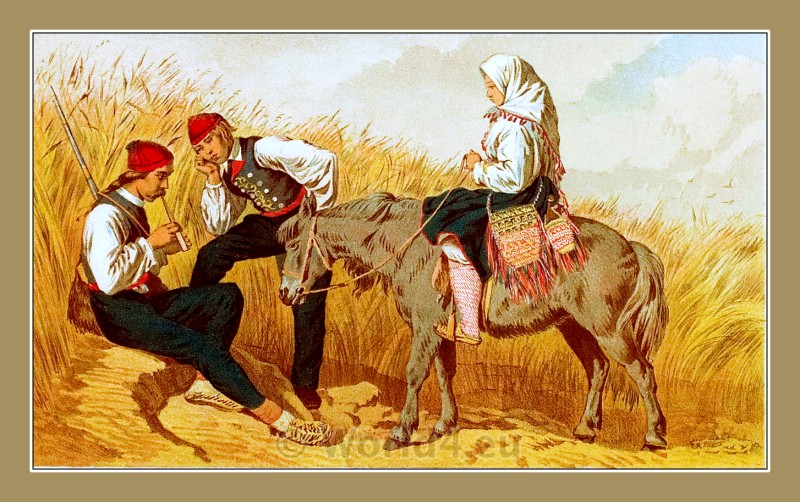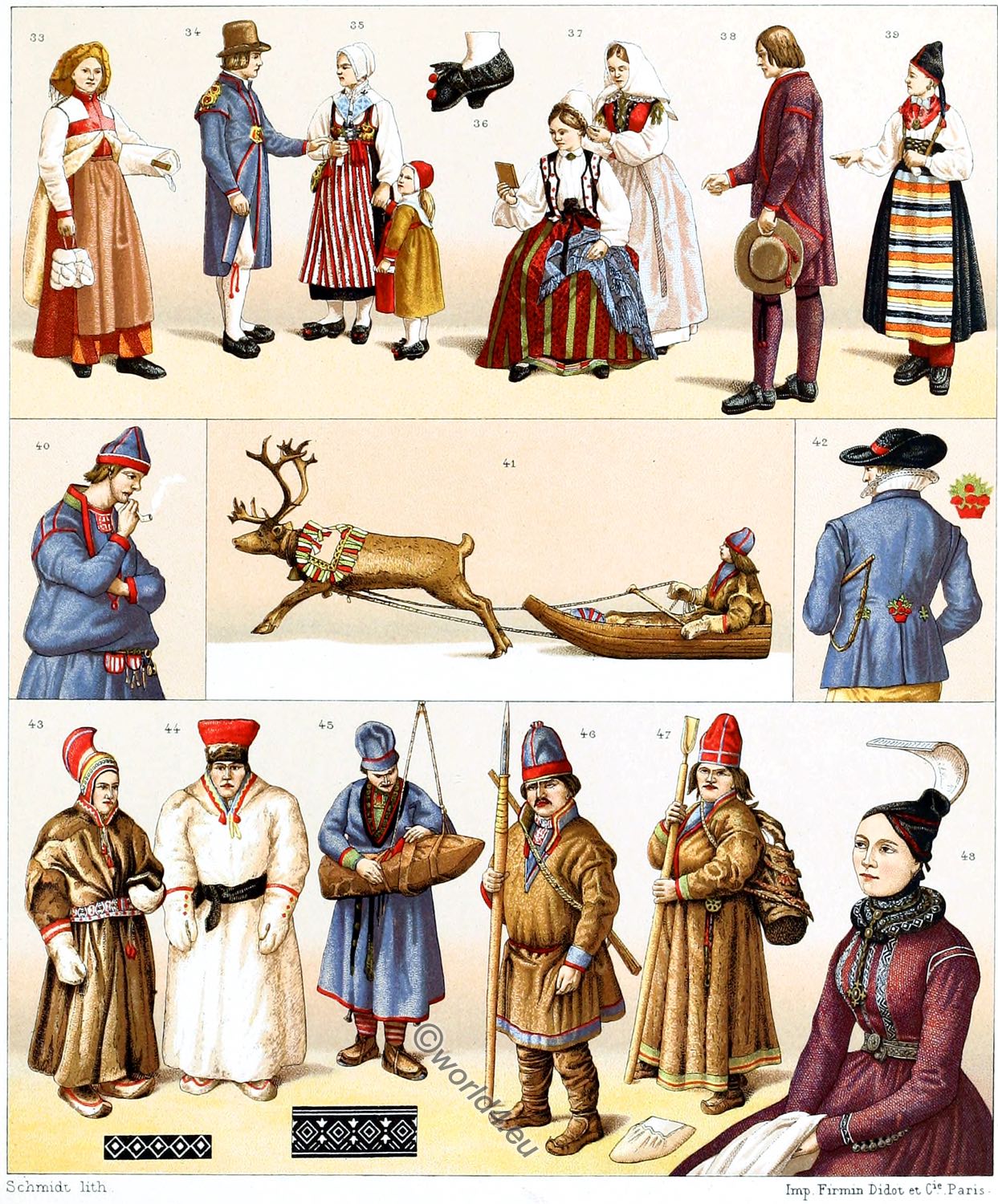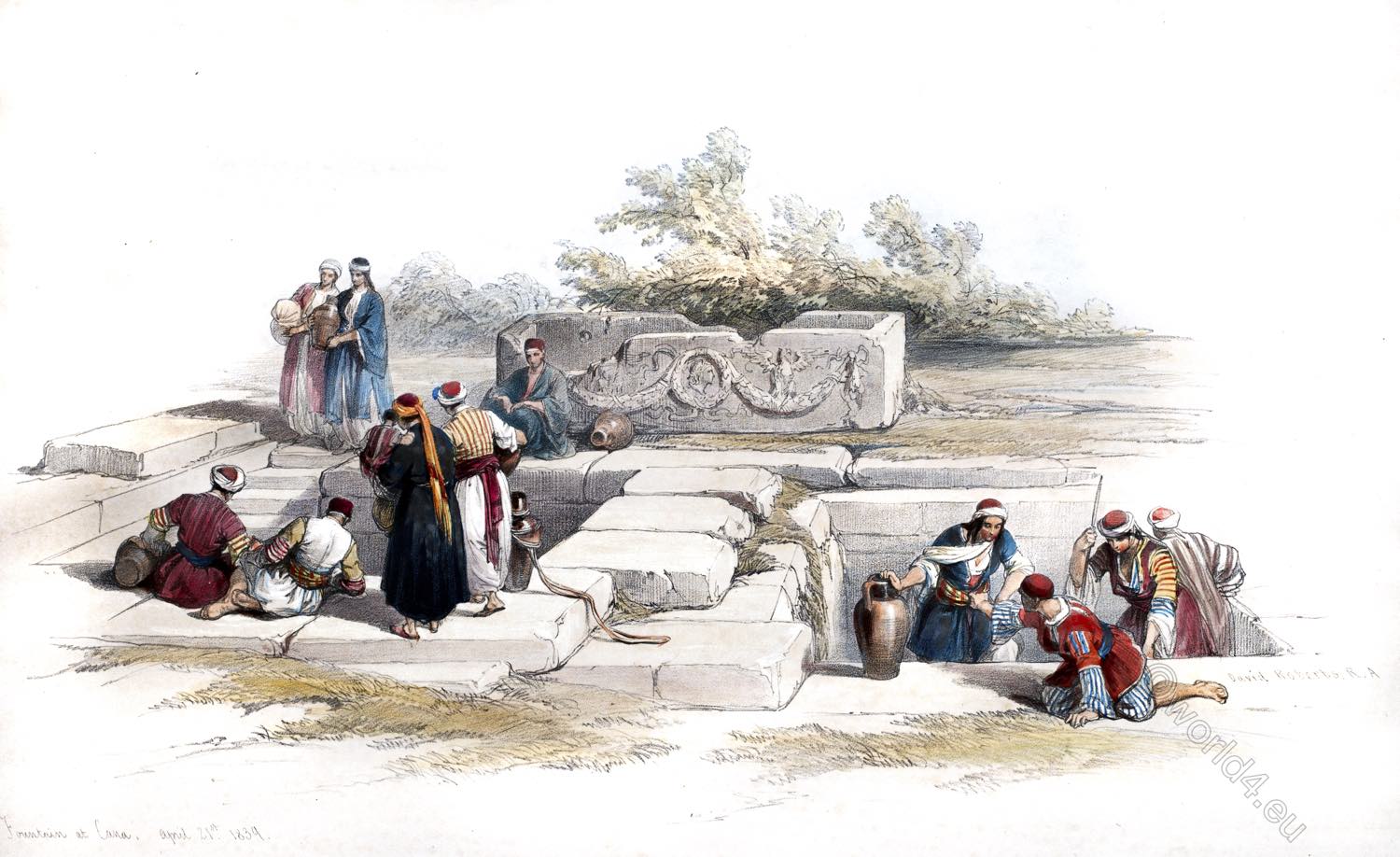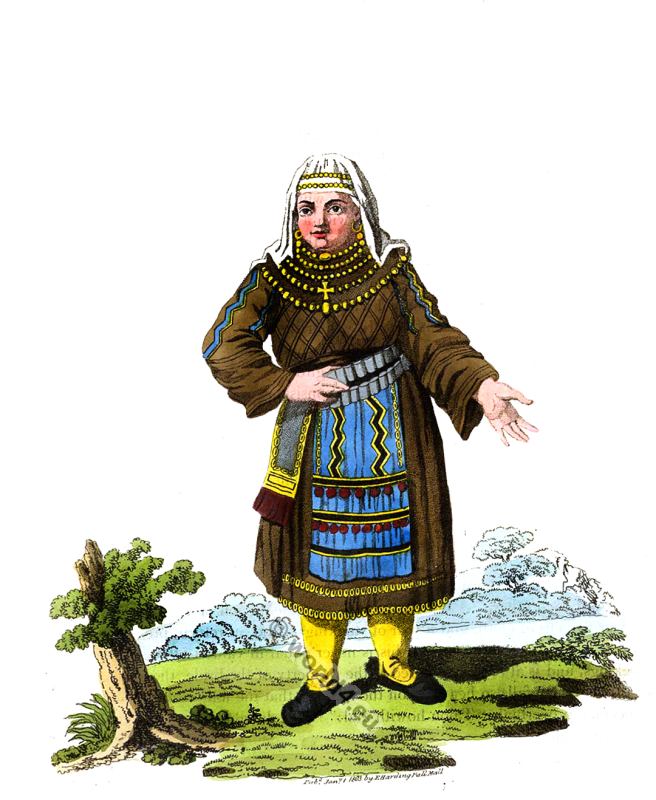LAPLAND.
Peasant art in Lapland.
The Sámi ( historically been known in English as Lapps or Laplanders) are an indigenous people in the north of Fennoscandinavia. Their settlement area stretches from the Swedish municipality of Idre in the province of Dalarnas län in the south to the northern parts of Sweden, Norway, Finland and in the north-east to the coasts of the White Sea and the Barents Sea in Russia. The original languages of the Sámi people belong to the family of Uralic languages and are therefore related to Finnish, Hungarian and Samoyed. The Russian Sámi people of the Kola Peninsula are considered to be the “indigenous small peoples of the north”.
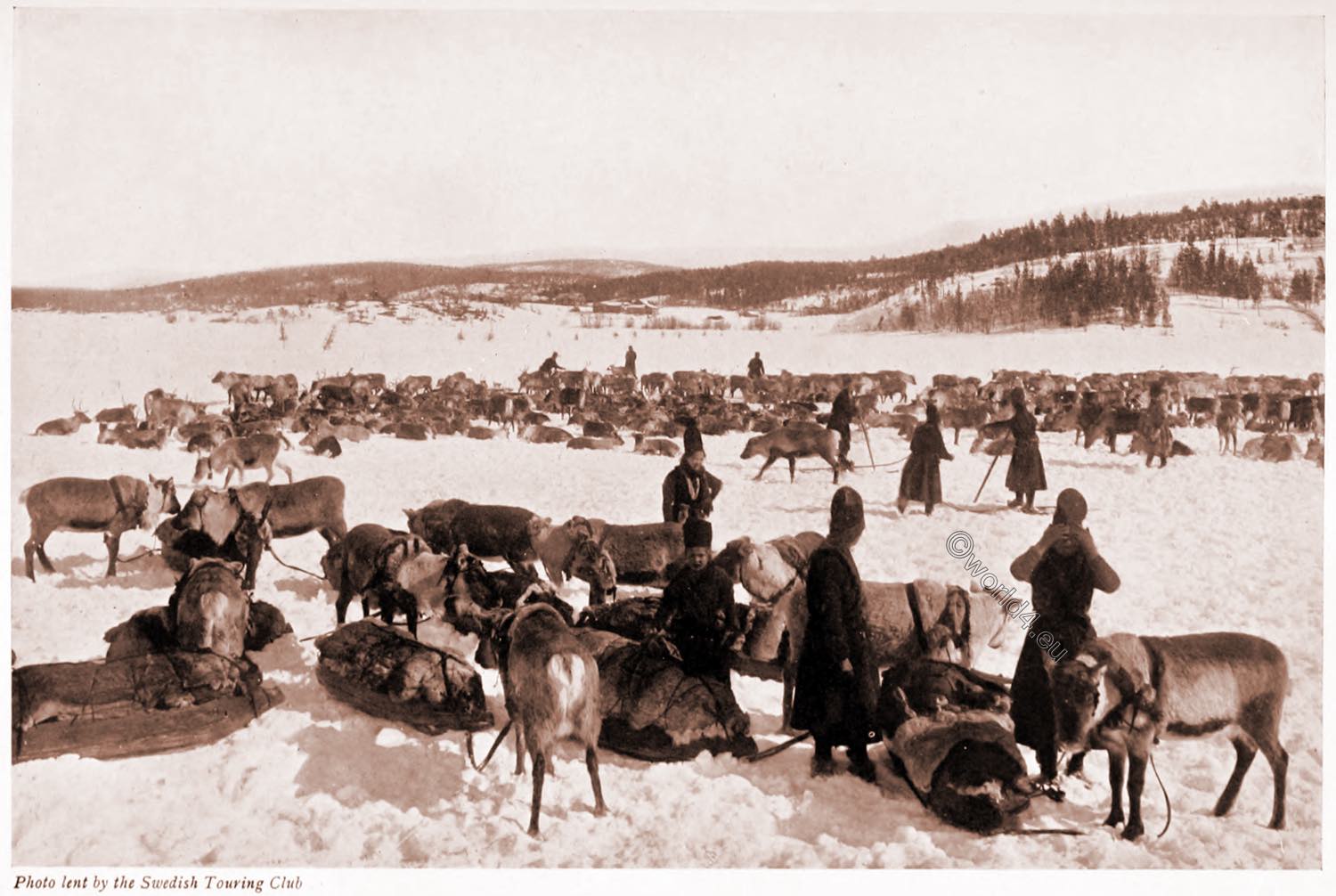
THE most northern parts of Sweden, Norway and Russia form the native country of those strange people the Lapps (Sámi). We can reach them comparatively easily, but every traveller returns full of astonishing reports of these extraordinary fellow-mortals. Although scientific explorers have taught us during these later centuries that Lapland is by no means “Nifelheim or Muspelheim,” and that its inhabitants are no frightful monsters or cyclops, we must own that their accounts introduce us to beings very unlike ourselves. In their country a pall of snow enwraps mountains and plains for almost eight months out of the year, and certain swamps do not thaw even in summer. Infin ite solitude seems to reign in these regions, whose extent is greater than France and Belgium together, though they are only populated by about 20,000 inhabitants. There the midnight sun and the aurora borealis display their phenomenal beauties, sombre forests cover large areas, wild torrents are fed by the ice-fields, numberless waterfalls and lakes enliven the scenery, and a variegated flora live where the rays of the sun brighten everything only for a few weeks during the year.
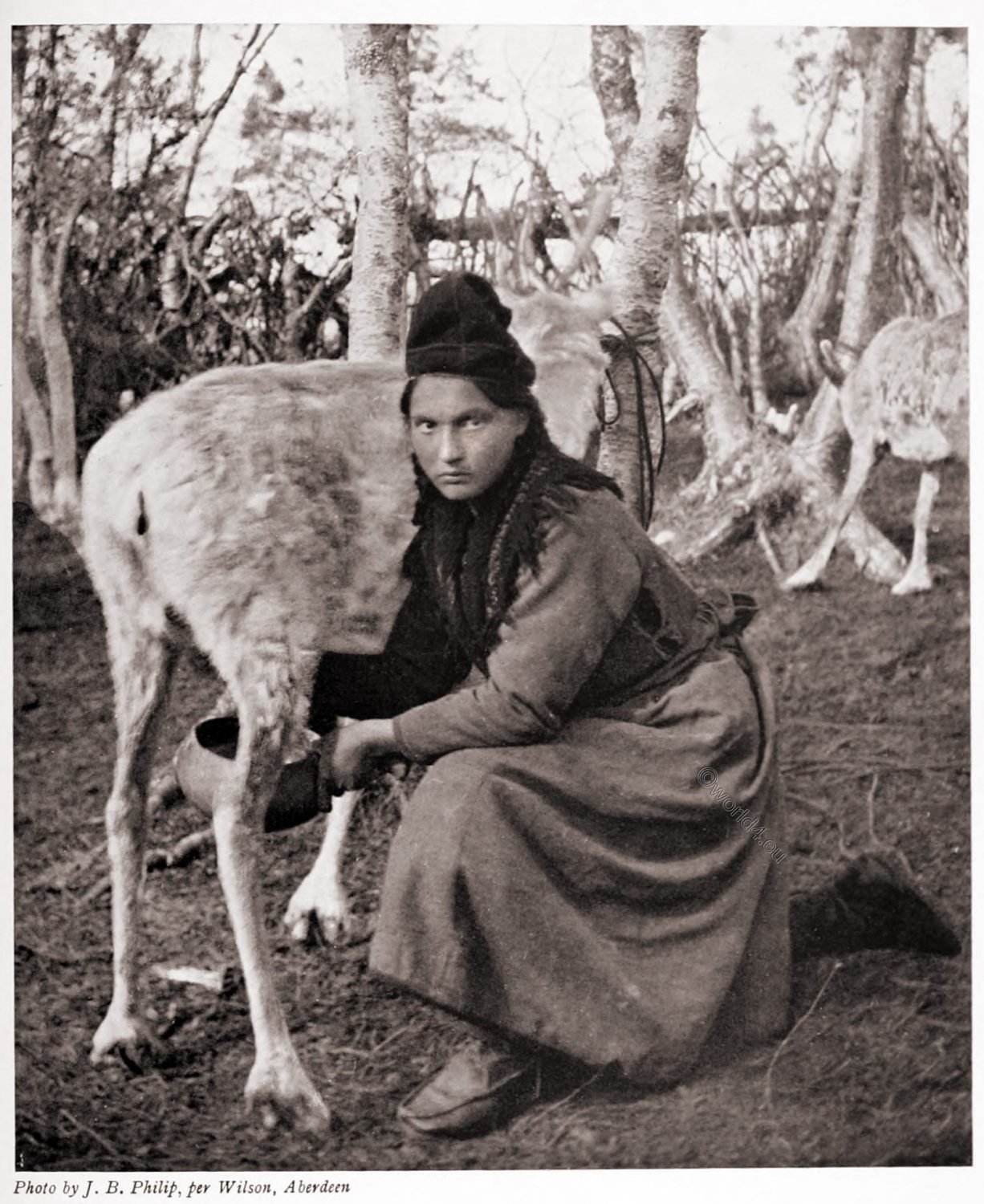
The Lapps must be considered only the ruin of a nation. They appear to be members of the Mongolian race, and their language points to direct relationship with the Finns. They are very anxious to preserve the purity of their blood and do not mix with other nations. “No, thank you; we wish to gnaw our own bones,” was the answer a Lapp from the small island of MaIm gave to a foreigner who had asked his daughter in marriage, for these M alm people disdain an alien son-in-law, even from one of the many neighboring isles. It is also related that a young Laplander who had become a soldier in the Swedish army, under Gustavus Adolphus, was promoted to the rank of a captain of horse. But as soon as he returned to his native land and to his own people, he wanted then only to live as a Lapp.
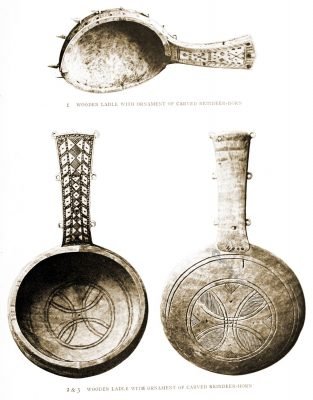
LAPLAND—DRINKING LADLES.
1 WOODEN LADLE WITH ORNAMENT OF CARVED REINDEER-HORN.
2 & 3 WOODEN LADLE WITH ORNAMENT OF CARVED REINDEER-HORN.
In the veins of these people the blood of primitive man is still circulating, and their language, manners and customs are of quite a peculiar stamp. Although the prophecy of Paracelsus has been fulfilled, and metals have produced much mining in Lapland, yet the people have remained peculiarly a cattle-breeding folk. The reindeer is their fate. It determines their residence when harbingers of Spring lure them to the grazing-places in the mountains, or. when Autumn gusts drive them down to protected valleys. The reindeer furnishes their dress and food, it provides the walls for their tents, covers for their sledges, utensils and chattels. References to it have enriched their language with many words, and when mountain Lapps meet, they greet each other with their “puorist” (“good-day”) and the three standing questions: How do you do? Have the reindeer much food? Is peace in the country?- which means, Did wolves attack the herds? The nomad state of the life is due to the wanderings of the reindeer. The houses can only be movable tents, for they must be put up where the reindeer decides to pasture.
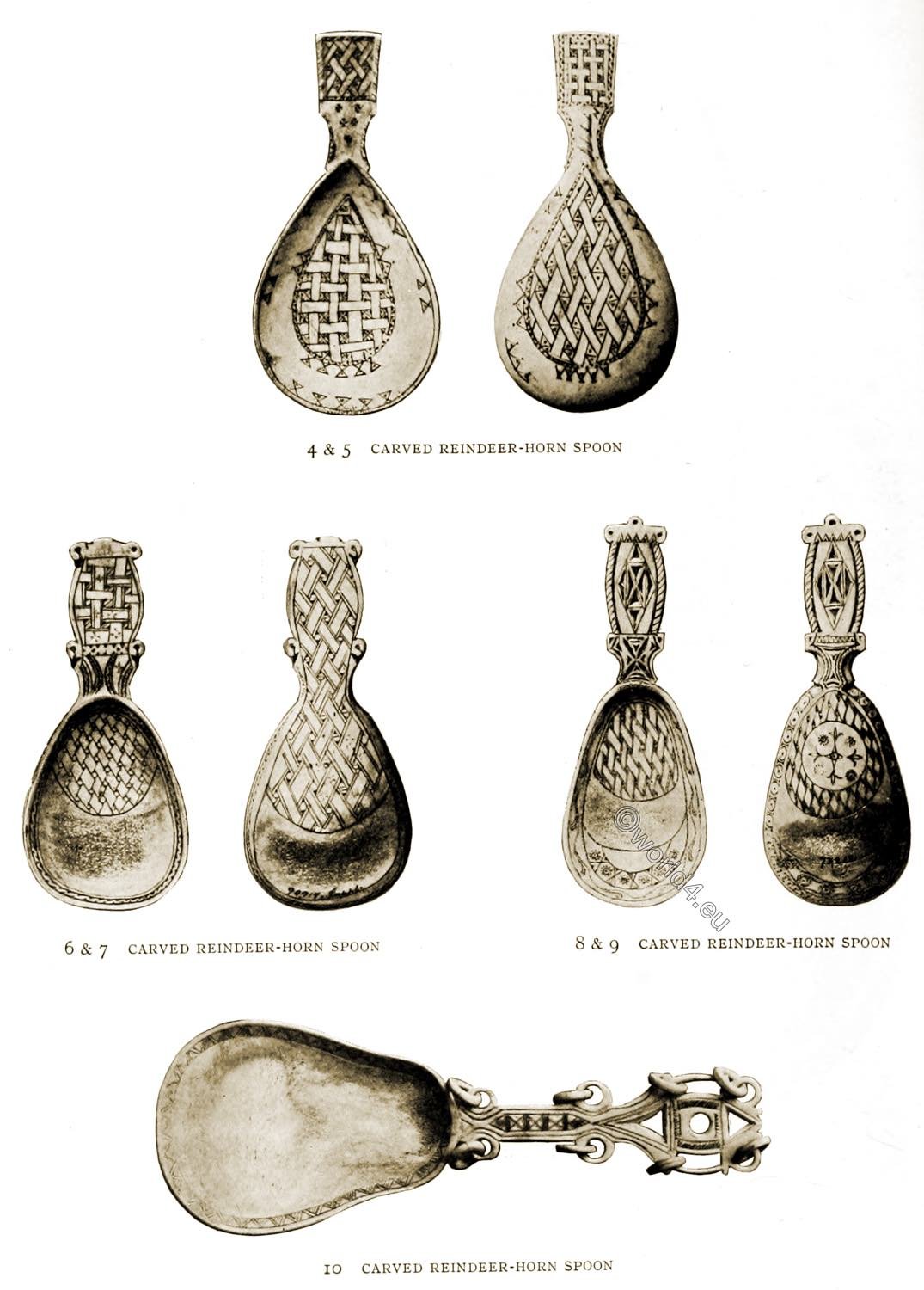
LAPLAND—SPOONS.
4 & 5 CARVED REINDEER-HORN SPOON.
6 & 7 CARVED REINDEER-HORN SPOON.
8 & 9 CARVED REINDEER-HORN SPOON.
10 CARVED REINDEER-HORN SPOON.
The Lapps are a very quiet people and can sit dozing like automata for hours round their fireplaces, yet their inner-life often betrays restlessness. Missionaries relate how they have seen them melting in tears at their prayers, and seduced to wrong-doings immediately afterwards. A kind of nomad-like fluctuation is shown also in their moral principle. The reindeer is, therefore, more to the Lapp than the camel is to the Arab, and the extensive possession of reindeer makes the rich man. This quadruped has caused the division of the people into Alp or Highland Lapps, and Sea or Coast Lapps, which form two totally different tribes. The mountain Lapp, the real nomad, looks down upon his settled brother who has given up roaming and is only fishing in the rivers or in the sea; but his contempt is boundless when the latter becomes a servant of the Scandinavian. Travelers agree in their characterization of the mountain Lapps as haughty, independent, quiet, dirty and suspicious, while they call the coast Lapps inoffensive, confiding, domestic and gay.
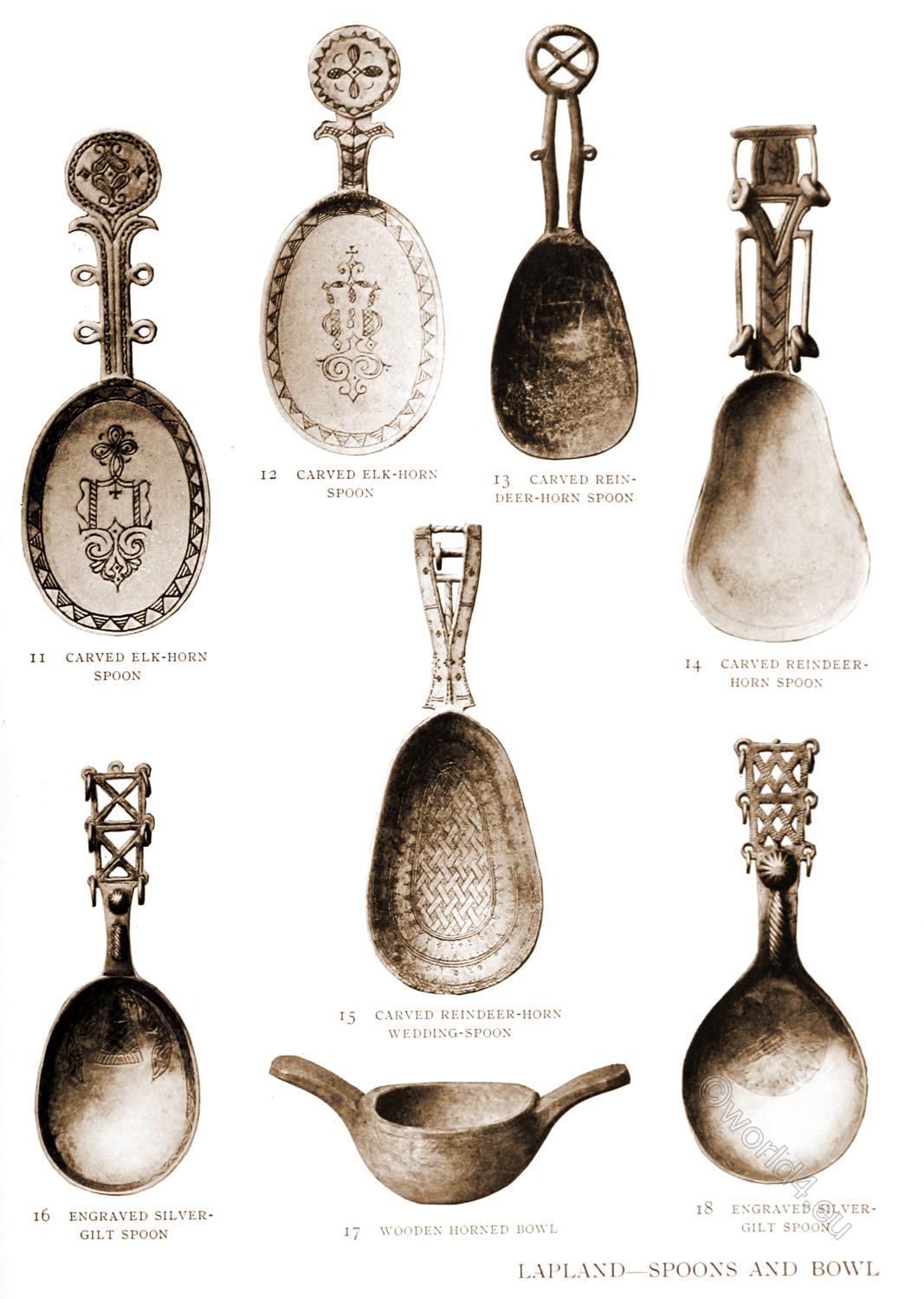
LAPLAND—SPOONS AND BOWL.
11 CARVED ELK-HORN SPOON.
12 CARVED ELK-HORN SPOON.
13 CARVED REIN-DEER-HORN SPOON.
14 CARVED REINDEER- HORN SPOON.
15 CARVED RENDEER-HORN WEDDING-SPOON.
16 ENGRAVED SILVER-GILT SPOON.
17 WOODEN HORNED BOWL.
18 ENGRAVED SILVER-GILT SPOON.
A kind of patriarchal system is practiced everywhere, and it is said that the family-ties of the Lapps are very strong. The Highlander is, by reason of his isolation, the purest exponent of the native character. Yet reports are very contradictory, and if we peruse statements made through the centuries, we have a feeling as if even the Lapps have gradually become more Europeanized, as if the whole register of vices and virtues, and all the complications and amiabilities of temper, are to be experienced in the company of those inhabitants of the ultimate snow-land. No chronicle has adequately stated the march of Lapland’s history. We have only very modest remnants of the country’s literature, and they offer reminiscences of a long-past epoch of heroes, when the sun was the principal deity and giants and sorcerers were alive. The religion of the early Lapps was heathenism, full of superstitions, fetishes and ghosts. They worshipped the sun and an image of Thor, and believed in an after-life of the soul, in a realm of light where pleasure and drink were superabundant. In the 13th century Christianity was brought to them during the reign of Hakon Hakonsen *), and since then missionary work has exerted a strong influence and brought about social reforms. Inspired by a Christian spirit, Maria Magdalena Mathsdotter, a Lapp woman of high reputation, a kind of Norse Jean d’Arc, went to the King in Stockholm, and stirred him to reforms in legislation and to the building of an infant-home. Queer things often happened among these Christians. Thus an old woman on her death-bed implored her pastor to help her rather into bell than into heaven, because he had told her so much about the fire there. “I have been freezing enough on this earth,” she argued.
*) Håkon IV. Håkonsson (1204 in Folkenborg, today Eidsberg (Østfold); † 16. December 1263 on the Orkney) was considered the son of King Håkon Sverresson and his concubine Inga von Varteig († 1234) and was King of Norway from 1217 to 1263. He is also called Håkon the Old (Norwegian Håkon Gamle) to distinguish him from his son Håkon Håkonsson unge (the young).
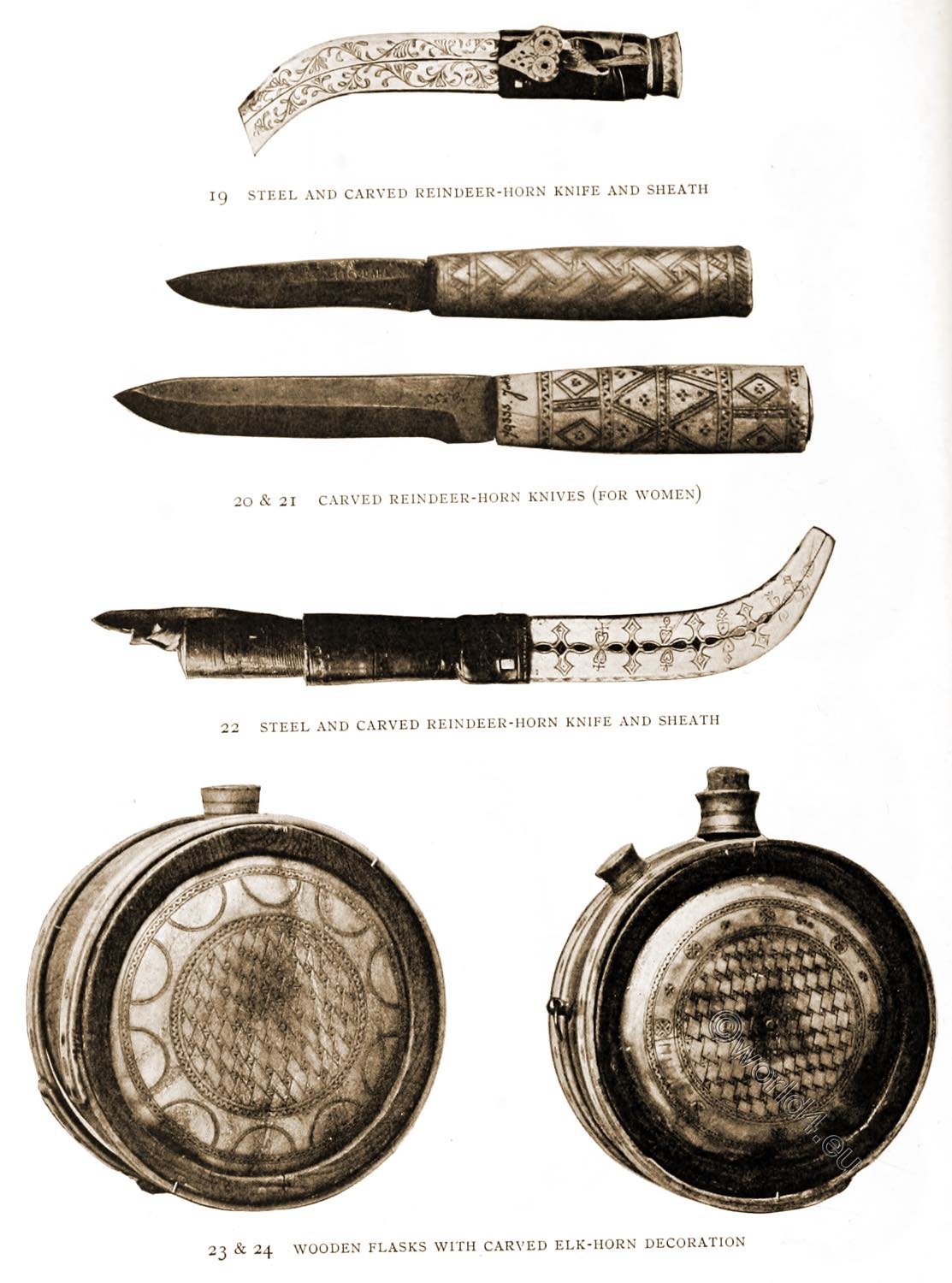
LAPLAND—KNIVES AND FLASKS.
19 STEEL AND CARVED REINDEER-HORN KNIFE AND SHEATH.
20 & 21 CARVED REINDEER-HORN KNIVES (FOR WOMEN).
22 STEEL AND CARVED REINDEER-HORN KNIFE AND SHEATH.
23 & 24 WOODEN FLASKS WITH CARVED ELK-HORN DECORATION.
Remnants of heathenish creed still linger in certain customs. Thus the magic drum is occasionally to be found. In former times it was secretly much in use as an oracle, and such an instrument is still considered so holy that it is carried as the last thing when the Lapps start, with all their property, on their marches. They wrap it up in lambskin, or in the soft feathers of a water-bird, and allow no marriageable maid to touch it, nor any woman to go the way it is carried, for this is said to portend harm. The drum is consulted on questions concerning hunting, diseases, sacrifices, and to obtain political and personal information. It is round or oval in shape, and is made out of the root-wood of pines, firs, or beeches, hollowed on one side over which a skin is stretched. Wooden pegs are used for fastening, and the sewing is done with reindeer sinews. The skin is painted over with pictures representing different gods, an image of Christ, some apostles, birds, stars, the sun and the moon. Below the sun we discern all sorts of terrestrial creatures, bears, wolves, reindeer, foxes and serpents, also marshes, lakes and rivers. The metal-rings of fate, which are shaped in different forms and decorated with chains, are laid upon the skin, and a hammer of reindeer-horn moves them by its beatings. All this is performed to the accompaniment of certain songs and the muttering of charms. The settling of the rings indicates the word of the oracle, and the Lapp who performs the ceremony falls down after it as in a trance. He sometimes lies for twenty-four hours, and when he rises is full of the spirit of prophecy. Travelers have brought such drums to the ethnographical museums, and even if we do not consider their historical meaning, they interest as works of handicraft, and testify to the manual skill and some primitive pictorial gifts of the Laplanders. Another superstition is connected with the mazical darts, and with the wind-knots which are still to be found. The Lapp believes some sorcerers can cause wind, or. stop it, by the mere opening or tying of certain knots. This belief is very old, and we find it mentioned in the ancient epic-poem, “Sons of the Sun,” in which the eloping giant-bride undoes several windknots and tbus compels her pursuing brothers to founder near the cliffs of the Lofoten Islands.
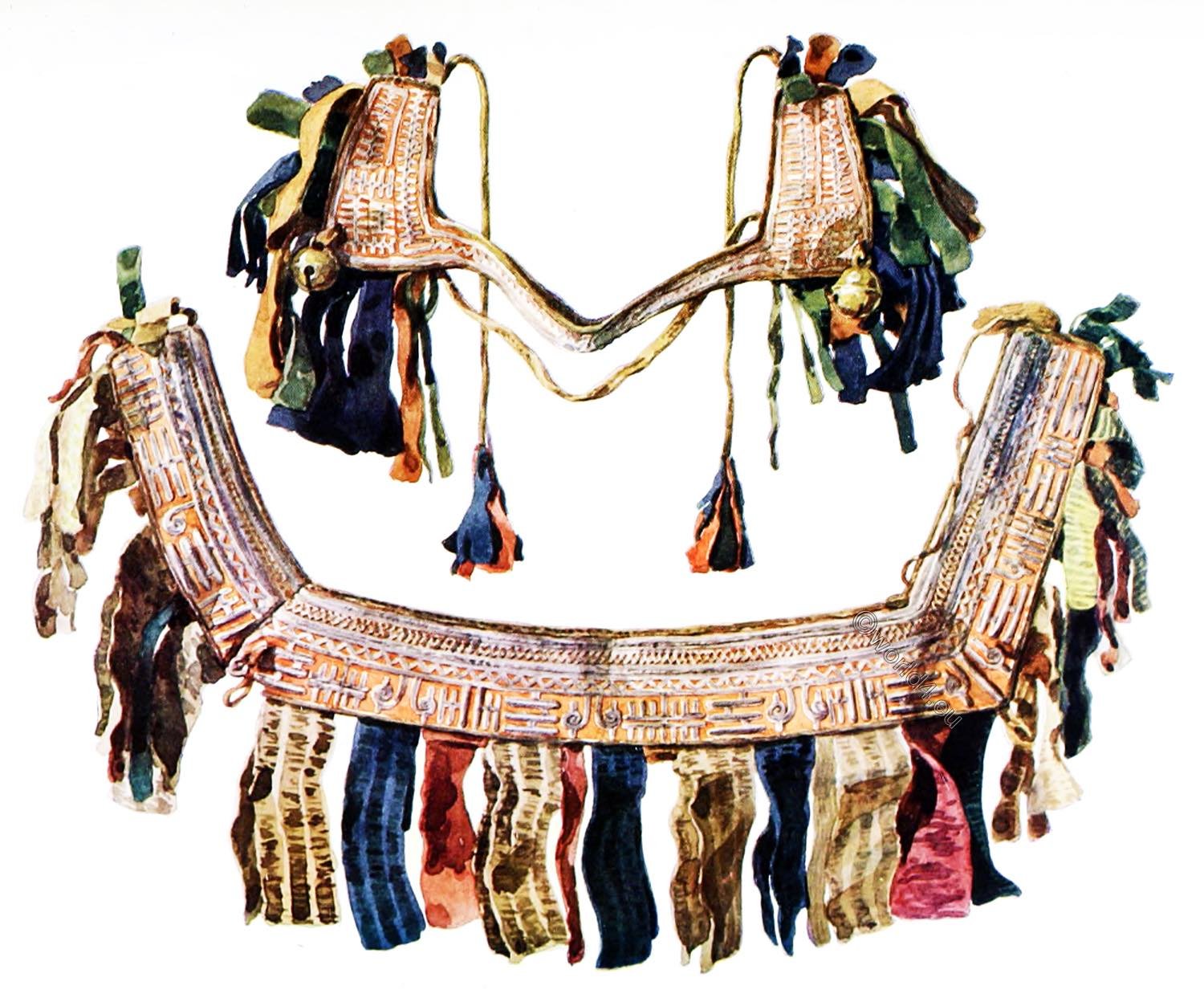
Lapp fingers are certainly skillful, and the divine gift of the sense of the beautiful has been distributed in that far north country. Not only the dress, but also all sorts of household goods and small articles, testify to the craftsman’s talent and sense of aesthetic necessity. The Laplanders use the skin of the reindeer and other furs for their garments, gloves, boots, shoes and caps, and they often adorn these possessions with charming embroideries. The coast Lapps also look very picturesque in snow-white or grey woolen frocks, ornamented with red or blue braid, girt with a colored sash. The men mostly wear blue caps and the women red ones, and the gayness of colouration is often quite striking in those snowy regions. The bridal costume, with its crown and ribbons, displays real rainbow glories, in some parts of the country, and this triumphal colour-symphony betrays nothing of the prosaic customs which precede the business of coupling two young souls. In fact bride and bridegroom are entirely left out of the question at first, their two families meeting and settling the bargain, with great consumption of brandy.
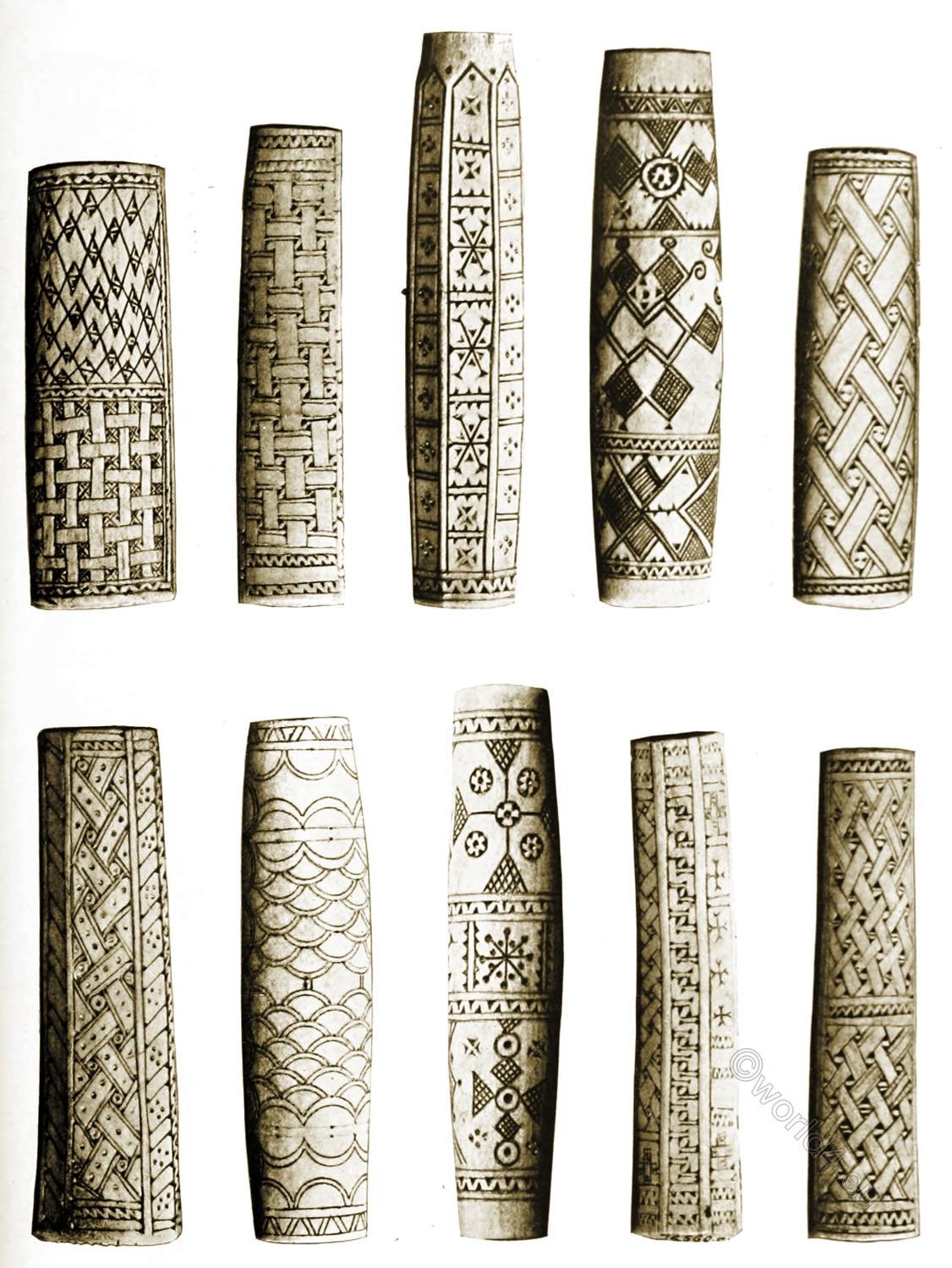
The Laplanders possess an instinct for decorating their persons with metal finery. Generally they keep such goods stored away in chests within their tents or shanties, but, especially on festive occasions, they love to make a display of their riches, quite like the peasants do in other parts of Europe. The Lapps wear broad belts, embroidered in silver, from which hangs a silver-adorned bag, containing a complete tinder-box, silver knives and spoons for the men; while the women also carry knives, a bag for the fire utensils, another bag for spoons, and a large kind of scrip which contains needles, reindeer thread, scissors and thimbles for sewing. Their vestments have costly parts, glittering fillets, girdles, spangles, buttons and rings showing off the owner’s wealth, as do the silver cups and tobacco boxes on their tables. On gala days even the sledges and the trappings for their reindeer bear remarkable adornments.
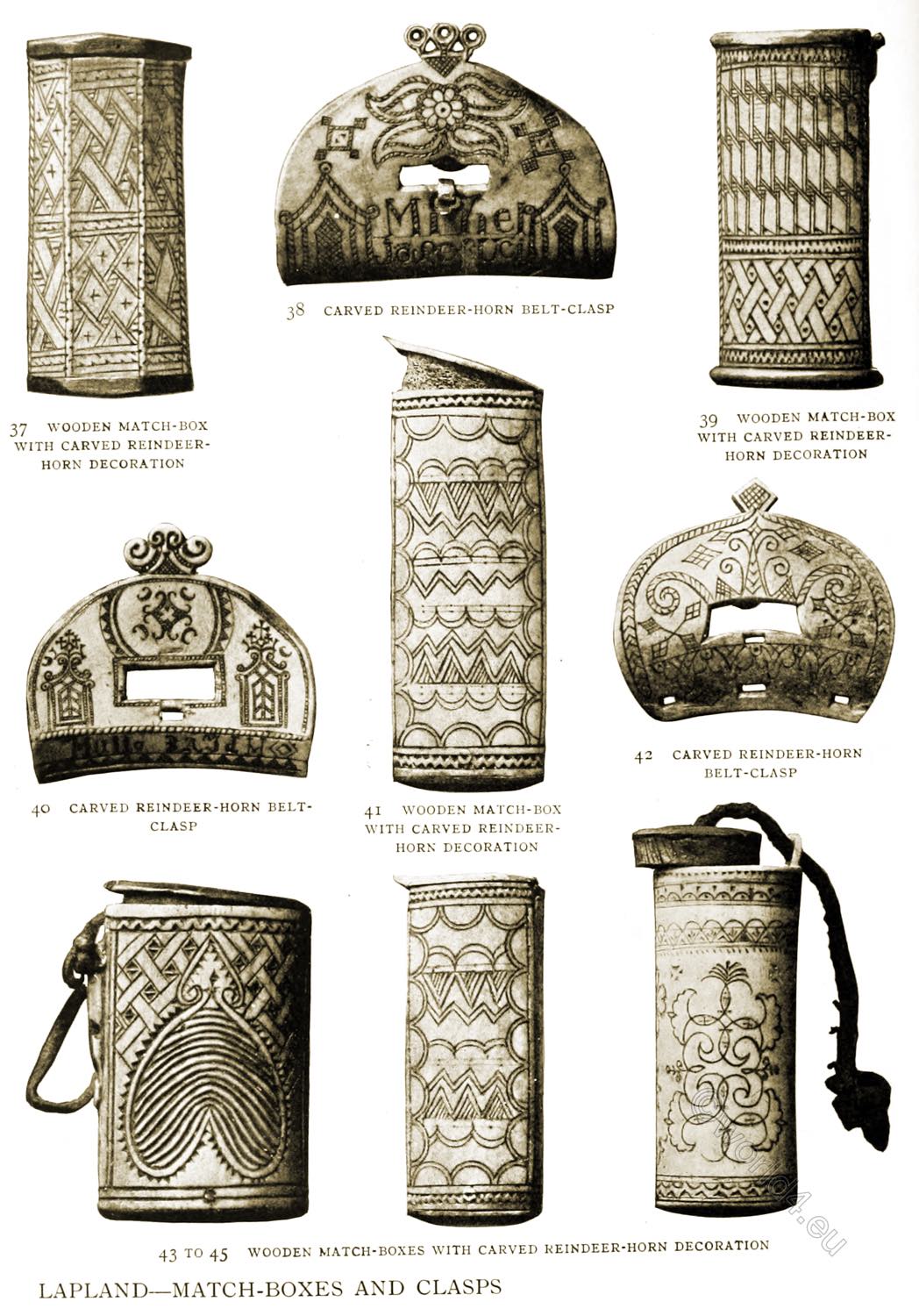
LAPLAND — MATCH-BOXES AND CLASPS.
37 WOODEN MATCH-BOX WITH CARVED REINDEER- HORN DECORATION.
38 CARVED REINDEER-HORN BELT-CLASP.
39 WOODEN MATCH-BOX WITH CARVED REINDEER- HORN DECORATION.
40 CARVED REINDEER-HORN BELT- CLASP.
41 WOODEN MATCH-BOX WITH CARVED REINDEER-HORN DECORATION.
42 CARVED REINDEER-HORN BELT-CLASP.
43 TO 45 WOODEN MATCH-BOXES WITH CARVED REINDEER-HORN DECORATION.
The men, who are very intent upon their trade, and who are responsible for the cooking and dressing of the food, are clever in several handicrafts. This knowledge is not acquired from masters of the trade, but handed down directly from father to son as a heritage. They make two or four-oared boats, and their skill is the greater as they can only fasten the deal or pine parts together with roots, twigs or reindeer-nerves. They construct sledges in the form of boats, without wheels and with a sort of keel. These vehicles, drawn by the reindeer, are said to go lightly and rapidly, but rather jerkily. Lapp sliding-shoes are famous for their practicableness, and help the wanderer to move nimbly over the snowy deserts.
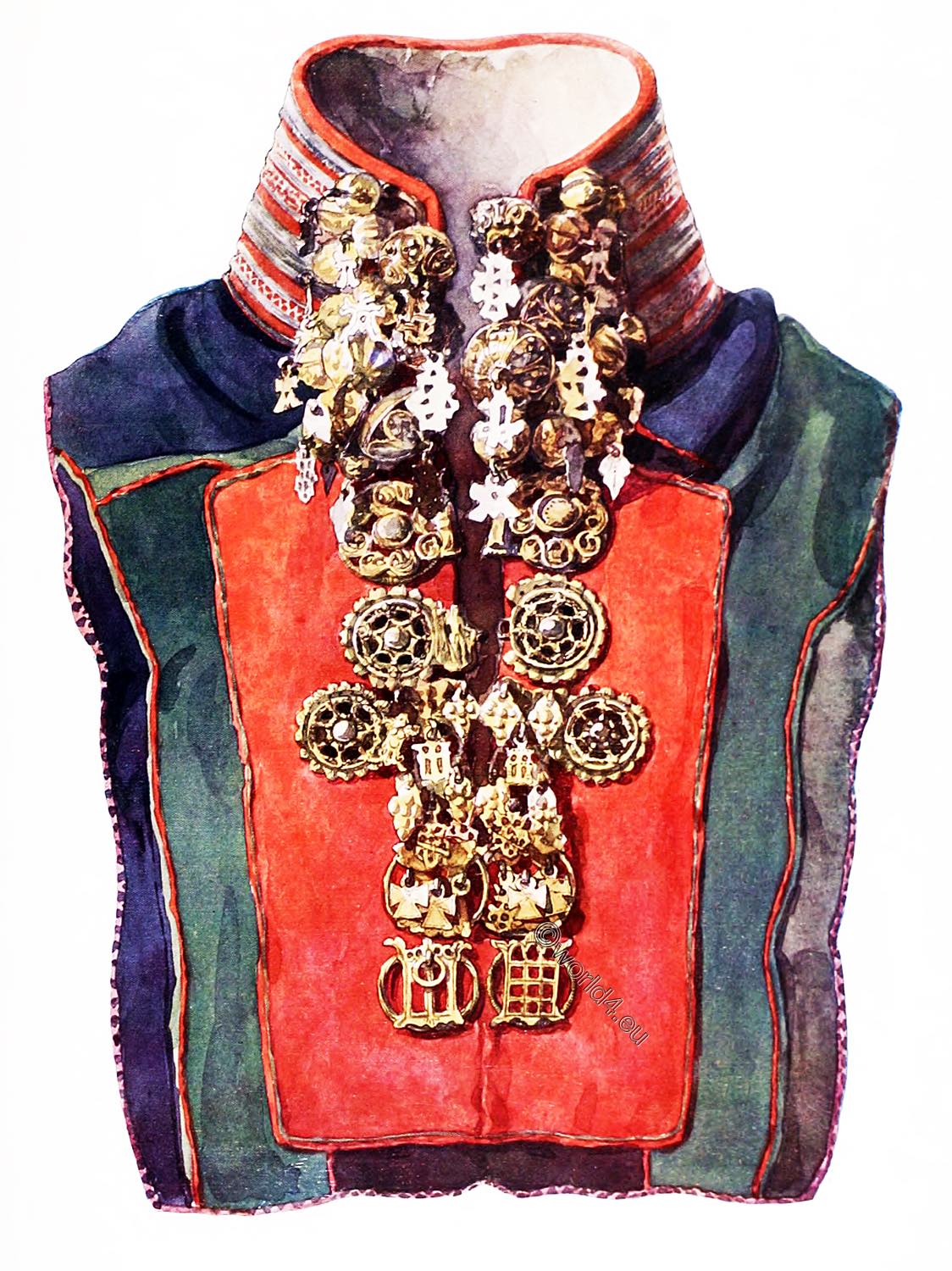
The men also execute boxes and chests, preferring to give them an oval shape, like their boats, for they can thus hid-pegs or twigs. Often they inlay such articles with pretty patterns of reindeer bone. Their cradles are very amusing; they consist of a kind of case made of birch-bark, into which the little parcel of humanity is pushed. A hole is left on the top for the child’s head, and the whole is covered with leather and lined with hairy reindeer skin. The child is wrapped up in very soft skins and packed so tightly that the custom of hanging up such precious parcels on sledges or reindeer-saddles, on a nail in the tent in summer, or on the branch of a tree, appears quite natural. Such appendages often look like strange fruits in the garden of Boreas. The Lapps are excellent rope-makers, and they can plait baskets of tree-roots, especially the birch, so firmly that water does not run through them. These baskets are of different shapes, round, square, or oblong, with or without a handle, and their exportation carries the fame of the Lapps’ dexterity into distant parts. Also all sorts of useful things are executed in wood or bone by the Laplander. He makes the cards for his play in alder-bark, and paints the figures on them with blood. He makes the moulds for tin-ware and bullets. We come upon weaving implements, shuttles, and combs, which tell us that this glory of the Scandinavian world has found a modest echo even here. But Lapp craftsmen are especially ingenious in making horn-spoons, and it is remarkable how clever they are in trimming them and their small boxes with different pendants and rings. Tools in these regions are utterly primitive, yet we often find excellent decorations of ornamental designs, floral and animal forms, executed by engraving or carving.
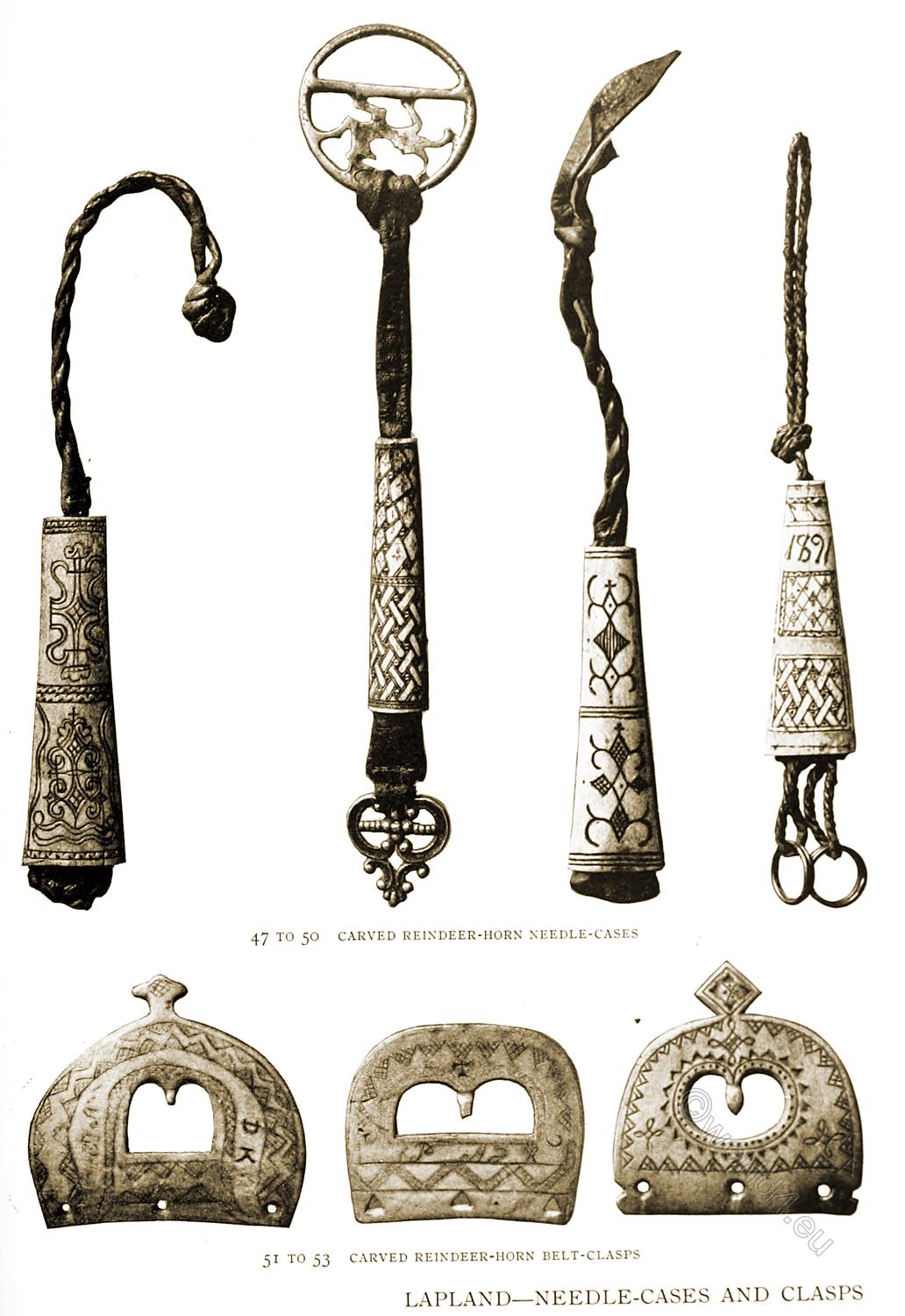
LAPLAND—NEEDLE-CASES AND CLASPS.
47 TO 50 CARVED REINDEER-HORN NEEDLE-CASES.
51 TO 53 CARVED REINDEER-HORN BELT-CLASPS.
The Lapp women, who are used to working hard with the children and the cattle, do all the tailoring and shoemaking. As flax does not grow in their country, they prepare a thread of reindeer sinew, which can only be of a limited length. They can also spin wool from hares’ fur, and can knit gloves, caps and stockings with it; and we are sometimes astonished at the nicety of these articles, their softness, elegance, and the pretty ornamental figures which the women know how to work into them. A traveller compared a Lapp woman, whom he saw sitting on a log of birch in her smoky hut, spinning, whilst the fire was smoldering in the gloom, to some mysterious witch working the thread of fate. But, above all, Lapp women are brilliant in embroidery, for which they have to prepare their own tin-threads. With these they get quite the effect of our silver-thread. They have also to draw the wire themselves, and accomplish this by pulling the metal with their teeth through holes in horn. By the help of the spindle these wires are twisted so tightly and evenly round the reindeer sinew, that each thread appears to be tin throughout. With these materials they embroider the different parts of their vestments, as well as the harness for their reindeer.
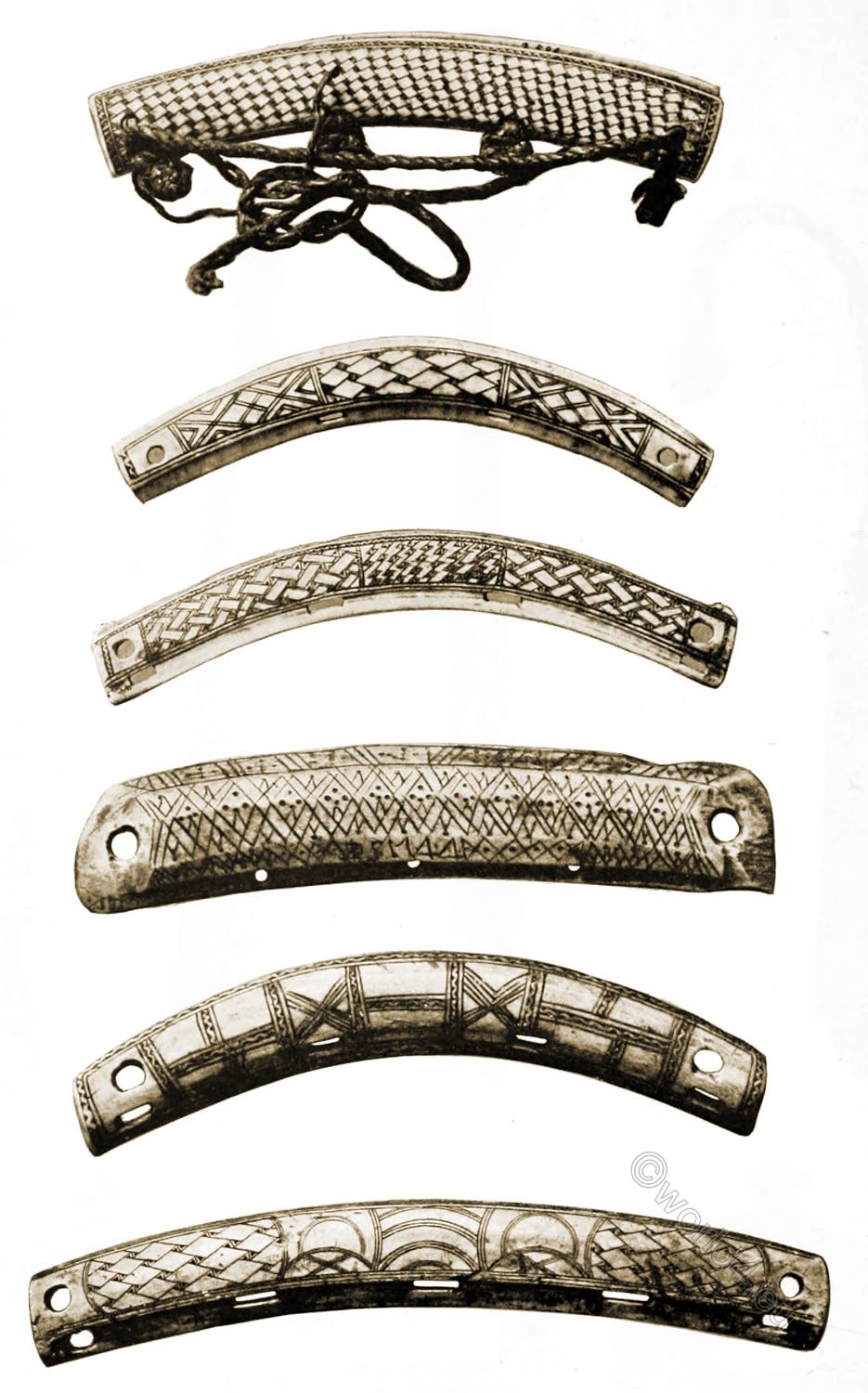
The designs of Laplandish carvings and engravings do not show the “horror vacui” of primitive people, nor do they betray the strange northern propensity for interlacing and fantastic combinations. Rather are they marked by reticence and simplicity. Most frequently we meet plaited motives of all kinds, which either extend over the whole object or only fill a part of it. Also a kind of chessboard pattern occurs, fish scales, or graceful ornamental figures and borderings, even floral forms, like delicate tendrils. The spirit of Christianity, which has gradually taken hold of the people, shows itself by the appearance of the cross. Varieties in shape are more numerous than varieties in design, and these we can study in the illustrations which accompany this article.
It was the opinion of Tacitus that only a native could like Lapland; but the more we penetrate the darkness which is massed around our arctic brethren, the clearer we understand the injustice of applying to them our customary epithet “primitive.”
JARNO JESSEN.
Anna Michaelson, pseudonym Jarno Jessen (* around 1868; † in April 1926 in Berlin), was a German cultural journalist, art writer and translator from English. Michaelson grew up in an educationally interested family with Jewish roots. Her sister was the writer Margarete Michaelson. She studied art history and gained recognition as an art writer. She has written for various magazines, including Die Gartenlaube, Daheim, Die Woche, Westermann’s Monatshefte, Die Kunst für Alle, Moderne Kunst, Die Kunstwelt and Deutsche Kunst und Dekoration. She lived in London for several years and maintained close contacts with the English art scene. For many years she worked as the Berlin correspondent of the British art magazine The Studio. As such she reported to her English-speaking audience on contemporary German cultural events, art movements and architectural trends. In Berlin she was a member of the German Women’s Club and the artists’ association “Die Kommenden”. (Source)
Source: Peasant art in Sweden, Lapland and Iceland by Charles Holme, Sten Granlund, Anna Michaelson. London, New York: ‘The Studio,’ ltd. 1910.
Related
Discover more from World4 Costume Culture History
Subscribe to get the latest posts sent to your email.

